|
systems, the power steering fluid is forced through the power steering system to amplify the force input from the driver, making it easy to steer and make turns. Why the fluid flush is necessaryMany will say flushing your power steering fluid isn't necessary. In the past, auto shops would replace the components of the power steering system as they went bad. With the advent of flushing systems, we can now flush and extend the life of the power steering components. The power steering fluid will wear over time due to daily driving and may become abrasive. It will also lose its ability to dissipate heat. The abrasiveness and overheating can lead to leaks and cracked seals, which are always expensive repairs. In extreme cases, the fluid will even form a thick sludge, further exasperating the effects of a worn fluid. Signs of bad fluiD It is relatively easy to check your power steering fluid. Since the system is fully sealed, your vehicle should not be losing fluid over time. If you notice your levels are decreasing, you may have a leak that requires immediate attention. Your vehicle's manual should have service intervals as well if you are unsure about your power steering fluid's health. It's better to err on the side of safety, so JAMHS Auto recommends a power steering flush every 30,000 miles to extend the life of your power steering system.
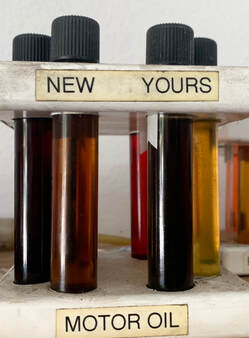 When you are driving, and you see that oil light you may be dreading bringing it into a shop to get it change. You might say "I can go a little while longer before getting it changed" then you forget about it and your engine is ruined. The oil in your car is one of the most important components to keeping your car "up and running". WHAT DOES ENGINE OIL DO? To understand why we need to change our oil, first, we to understand exactly what your engine oil does. Every engine needs oil, but not just any oil. Every vehicle has its own standards and requirements when it comes to the type of oil you should be using. To put it simply, base oils are the backbone of the lubricant that ends up in your engine. They can be conventional, synthetic, a blend or high-mileage. Over time, your engine oil begins to wear out. This causes the oil to become increasingly less effective at lubricating your engine’s parts and absorbing heat. WHAT HAPPENS IF YOU DONT CHANGE YOUR OIL? If you don't change your oil your engine oil begins to break down and wear out. If your oil continues to run through your engine unchanged, you’ll begin to face a list of problems. If you wait too long for an oil change, your smooth and clean oil will turn into dirty sludge As car a owner you should change your oil about every 5,000 miles so that your oil doesn't change to sludge and your car can still run smoothly. SIGNS OF BAD ENGINE OIL.
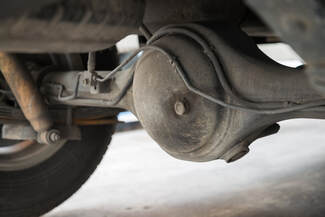 The front purpose of the differential is to manage the rotation of your vehicle's wheels. In front-wheel drive (FWD) vehicles, the transmission connects directly to the differential. In contrast, the differential in rear-wheel drive (RWD) sits between the two rear wheels of the vehicle. All-wheel drive (AWD) and similar vehicles will contain both a front differential and a rear differential. The differential is important in making turns and driving on uneven terrain. It allows your wheels to turn at different speeds to prevent skidding of the tires. It also works to prevent loss of traction in soft or uneven terrain (such as dirt roads). The Importance of Differential FluidThe differential fluid is usually referred to as differential oil or gear oil. The oil in your differential works to dissipate heat and lubricate the gears. Much like the engine oil, it will lose its ability to lubricate over time and requires regular service. Without healthy differential oil, the differential will rapidly overheat and wear down the gears. Is it time to change? If you've driven over 40,000 miles, it might be a good time to check the fluid. If you hear strange sounds from the differential, such as grinding or howling, it might be too late. At that point, the lack of lubrication has already damaged your gears. Another sign of bad differential oil is a burning smell. The oil will burn when it is no longer able to dissipate heat as it should. Check your vehicle's manual for a specific time interval. JAMHS Auto recommends a differential flush every 30,000 miles as part of your driveline service.
Recently, a customer came in complaining of vibrations from the wheels while driving. They previously took their vehicle to a chain shop. The shop rotated and balanced the tires, but the customer was ultimately left unsatisfied as the issue promptly returned. After a quick test drive at JAMHS Auto, the problem was obvious. The tires were not properly balanced. The cause of the tire imbalance was probably not due to any fault of the previous shop's technicians. The particular vehicle in question had cladded wheels. Cladded wheels are wheels that have aluminum rims that are coated with plastic, often chrome-colored. The plastic is relatively fragile and is easy to chip when balancing or changing tires. 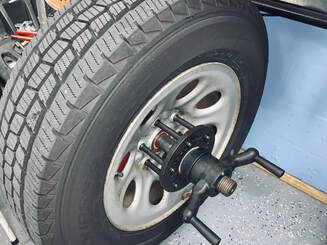 Wheel mounted to balancer using precision flange plate Wheel mounted to balancer using precision flange plate Clad wheels require special tools to balance. Generally, a tire balancer will use a cone-shaped mount along with a tapered collet. While these tools work for steel and non-cladded wheels, cladded wheels require a precision flange plate that only contacts the lug holes of the rim. Without the special tools, the tire balancer may show zero, indicating the tire is fully balanced. The pressure from cone mounts can also crack the plastic, leading to the replacement of the entire wheel. If a shop doesn't have the correct precision collets and flange plates, the wheel cannot be secured tightly enough on the balancer leading to inaccurate measurements. Here at JAMHS Auto we will make sure to do the job right the first time. 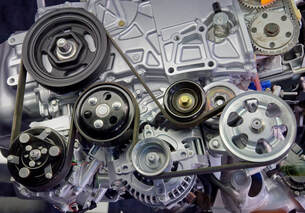 The timing and serpentine belts are the two belts of concern when dealing with vehicle maintenance. The serpentine belt transmits power from the engine to various accessory components, from the power steering pump and alternator to the air conditioning and water pump. The timing belt performs a vital role in ensuring all the engine components are working together. It connects the crankshaft to the camshaft to synchronize all of the movements and prevent collisions in the engine. Signs of a bad beltIn older vehicles, it's easy to see the cracks and overall wear of the belts to assess their health. Newer belts, however, are made with more durable materials that generally will not crack. Common signs of a bad belt:
|
Archives
May 2024
Categories |

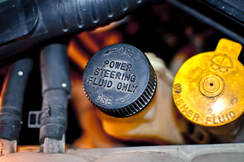
 RSS Feed
RSS Feed